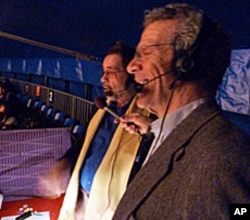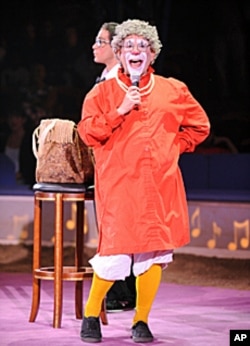Does The Big Apple Circus Have Animals
Children the world over beloved a circus. Just young people who are visually or hearing impaired can find it about incommunicable to join in on the fun. Since 1983, the producers of New York's Big Apple Circus have been bringing those special needs children into the deed with the annual "Circus of the Senses" program.
Midway through a recent operation, all of the action takes place in a small, one-band production. About 1,200 children - most of them visually or hearing impaired - sit down in rapt attention, their faces aglow in the testify'due south dancing, colored lights.
As they watch the incommunicable torso-angle moves of Mongolian contortionists, announcers describe the action from a sound booth located behind the crowd.
"Oh, my! There's one young lady on the pedestal and everybody else is balancing in some kind of backbend on her."
"When we say back curve, it'due south all the way, their legs are almost to their heads."
Paul Binder and Michael Christensen's commentary goes directly into headsets worn by the visually impaired children. Binder and Christensen co-founded the not-profit Large Apple Circus in 1977 to make this traditional and popular form of entertainment more accessible to communities across the country.
"So in that spirit, we want to brand the delight, the joy, the wonder, the excitement of the ane-ring circus available to every bit many varied populations as we can," says Christensen.
He says the idea for the Circus of the Senses arose when they realized some populations need extra help to share in the circus fun. In order to bring the experience to the visually impaired, the two received extensive coaching from professional 'audio describers' and from bullheaded people. Christensen says they learned that their running descriptions had to stay ahead of the action in the ring, and ahead of the excited gasps from the 'seeing' crowd. Information technology's not enough to merely react.
"If you cannot see our show and nosotros are describing a triple somersault, and we draw that triple somersault as it happens, you may hear the audience effectually you gasp because they will see the somersaults, so you are kind of left out of that gasp," says Christensen. "And then whenever we can, we anticipate that triple somersault, so that you hear it described at the aforementioned fourth dimension people encounter it then yous tin join the collective gasp."
Christensen adds that he and Binder take pains to be careful with the oral communication they use. But the blind people who motorbus them have warned them against being as well conscientious.
"We were always very sensitive about phrases like 'Look at that!,' or 'Did you see that!' And when we brought that issue upwards to the bullheaded person who was giving us notes, he said "Don't worry about that. That'due south silly. Just say information technology like that. Information technology's fine.'"
The deaf and hard of hearing are as well fully accommodated at the Circus of the Senses. Anne Tramon, who helped create Circus of the Senses, notes performance features several highly-trained American Sign Linguistic communication interpreters. Tramon besides helped to develop a headphone device that uses infrared lite to convey sound to listeners faster than sound waves.
"And because you are isolating the sound, you lot are taking audio direct from the stage through the (sound) feed, you are getting this pure sound and you can still hear the audience considering it's not completely blocked, your ear," she says. "And to encounter a kid truly feel something they could never experience before, it's just amazing. It does the middle good."
Afterwards the bear witness is over, there is a special touch session, where young audience members tin can enter the band, meet the performers and impact the animals they may not have been able to see, or see well.
"Nosotros every bit performers actually get to meet the audience. Information technology's not simply the audition getting to run into united states and getting to pet a dog or a goat or a horse today," says Barry Lubin, a professional clown with the circus. "Some of these people I've seen since they were very young. And now they're getting older and their families are still bringing them to Circus of the Senses. Information technology's a slap-up experience for me every year."
The Circus of the Senses, which will exist performed twice this yr in New York and Boston, is not the only community service performed by the Big Apple Circus. It also sponsors Clown Care, a program which sends clowns and the cheer they bring to pediatric hospitals.
Source: https://www.voanews.com/a/big-apple-circus-focuses-on-the-senses-114221414/162411.html
Posted by: clarksonoblipt58.blogspot.com



0 Response to "Does The Big Apple Circus Have Animals"
Post a Comment